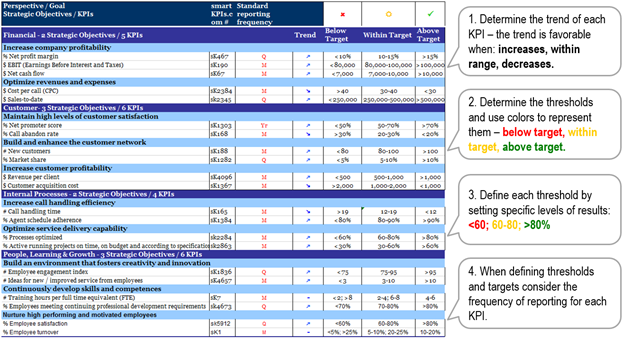Good practices in setting targets
Targets provide a reference point against which performance is measured. If targets are high or low, they can significantly affect the analysis of KPI’s results. Some analysts consider that stretch targets are the way to success, while others believe is better not to set targets at all.
A stretch target is a target that cannot be achieved unless a major change takes place and people start thinking differently and adopt a different strategy. However, there is a fine line between a good stretch target that drives performance and the one that demotivates, by being too hard to achieve.
Good practices in establishing targets:
Technical aspects

- Set target based on thorough research – the company’s historical data, benchmarking studies, and market analysis can provide valuable information and reference points in determining the appropriate level of targets.
- Set short and long term targets – it long term targets can be decomposed into smaller ones, ensuring a step by step approach. This ensures a sustainable development of the company.
- Cascade targets top-down – target alignment should be ensured, by cascading them from top management, down to employee level.
- Instead of having only one target, consider using thresholds – they show the intervals in which KPI results can range, providing a more detailed image in regards to performance. KPIs in the yellow threshold may not have met the target, but as they are still in the acceptable interval, they may not require immediate action, as the KPIs in the red threshold.
- Test and adjust targets – testing targets for 3 or 6 months can outline if the company is on the right track. Adjustments should be made as often as necessary, in order to ensure the relevancy of the targets.
- Establish initiatives that support the achievement of targets – to improve performance, changes are necessary, and this can be achieved by implementing several initiatives or projects.
Continuously review and update targets – setting targets is not a one-time event, it is a permanent process that involves periodical reviews and updates of targets.
Social aspects:
In some cases, setting targets and being too oriented towards results, can lead to negative behaviors among employees. In order to avoid tunnel behavior, lack of ethics or risky decisions, it is important to ensure a proper environment to work with targets:
- The organizational culture has to promote constant learning and improvement – in thsis way performance evaluations will be regarded as positive events, instead of stressful meetings;
- Employees have to understand clearly their job and the performance expectations – people are more likely to perform well and accept targets, as long as they are aware of their responsibilities from the beginning.
- Involve target owners in the target setting process – employees will be more determined to achieve targets, if they participate in the process of establishing them.
- Do not immediately link targets to financial incentives – there are other effective ways to motivate employees to perform better, including the public recognition of performance. Financial incentives can drive tunnel behavior, and some employees may even act unethically, in order to get a bonus.
- Celebrate and reward even small achievements – some targets may be very hard to achieve or might take longer. To keep employees motivated, is important to acknowledge and reward even smaller accomplishments.
References:
- Brudan, A. (2013), Target setting for key performance indicators, MILE Webinars
- Behn, R. B. (2011), The value of setting stretch targets, Harvard Journal, Volume 10, Number 4
- Franco-Santos, M. and Bourne, M. (2008), The impact of performance targets on behavior: A close look at sales force contexts







